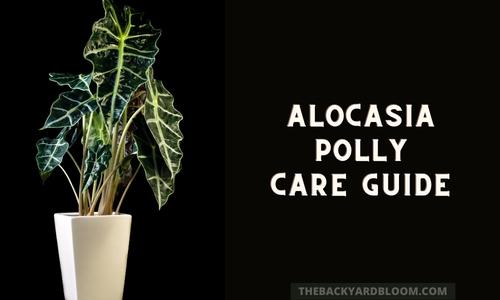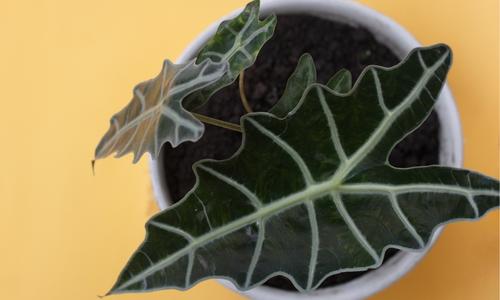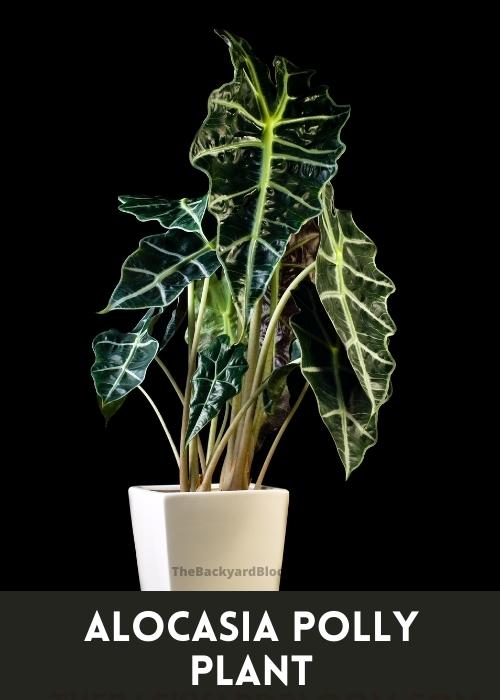The Alocasia Polly is a unique looking houseplant that many people pick up when they find it in the store but they don’t know how to care for one properly. This leads to many frustrated plant owners having a sick looking Alocasia because they were given the wrong information when they got their plant. In this care guide, we go over all you need to know on how to take care of an Alocasia Polly.
Origins
The Alocasia Polly is considered a child plant of the Alocasia x amazonica. There is not much information on where or how it came about. Just that the Alocasia x Amazonica was a result of someone breeding Alocasias in a Florida plant nursery.
Alocasia Polly Scientific Name
The Alocasia Polly does not have an official scientific name, but when referenced by botanical professionals it is called: Alocasia × amazonica ‘Polly’
Other Names for The Alocasia Polly:
- African Mask Plant
- Elephants Ear
- Amazonian Elephant Ear
Alocasia Polly Vs Alocasia Amazonica
Often people will say that the Alocasia Polly and Amazonica are the same plants. But that is not true.
The Amazonica, or Alocasia x Amazonica was originally bred in the 1950s in Florida by Salvadore Mauro.
The Alocasia x Amazonica ‘Polly’ is listed as a child of the Alocasia x Amazonica that was probably a result of the same breeding program or another one that followed the discovery of the Alocasia x Amazonica.
The Polly is smaller in size, with the Amazonica being about twice as big with larger leaves.
Care for both is mostly the same, with the Polly just being a more compact version of the two plants.

Quick Overview on How to Care for an Alocasia Polly
- Water once the top two inches of soil has dried out. Use filtered or distilled water.
- Bright indirect light is best.
- Use well-draining aroid soil.
- Use a pot that allows for drainage.
- Fertilize once a month at half-strength with a regular houseplant fertilizer. Do not fertilize in the winter.
- Temperatures: 65°F – 80°F
- Humidity: 40% – 70%
Other Alocasia Care Guides:
Alocasia Polly Watering
Like other Alocasias, the Alocasia Polly requires some extra attention to watering.
You want to water them when the soil moisture has gotten dry in the first top few inches of soil.
Don’t try to stick to a watering schedule with these houseplants, as their water needs will change depending on the season and their current growth phase.
Make sure not to let all of the soil in the pot dry out between watering your plant. These plants cannot get too dry or they will start to have issues with their foliage and growth.
Always use filtered, distilled, or rainwater when you water your Alocasia Polly. Do not water with regular tap water. Chemical additives and hard metals can cause issues with these plants.
If your Alocasia is in the process of growing new leaves, it will need to be watered more often. If you see new growth on your Alocasia Polly, check the soil moisture at least every other day. Without enough water, it is easy to lose the new leaf that is growing.
Alocasia Polly Light
The Alocasia Polly grows best in bright indirect light.
Direct sunlight can cause the plant to get burn damage, so make sure that you aren’t putting your Alocasia in an area where the sun will be directly on it, especially during the mid part of the day. Morning sunlight for a brief part of the early day is ok for these plants.
If you notice that your Polly is starting to look leggy or is leaning towards the light source, then you should move it to a location that has more light. Rotating your plant regularly can also help avoid leaning towards the light source.

Alocasia Polly Soil
A well-draining aroid soil mix is best for an Alocasia Polly, but the soil should also have some ability for the soil to retain a bit of moisture. If the soil continuously dries out the plant will have issues with dropping leaves and losing new growth.
Some options for good soil mixes would be to make your own with equal parts potting soil, orchid bark, perlite, and worm castings. There are also premade aroid soil mixes available from places such as Amazon.
Size
The Alocasia Polly can grow up to 2 feet tall and 2 feet wide.

Pots
What pot you use for your Alocasia Polly really depends on your watering style. Always pick a pot that has drainage.
If you tend to overwater, then terracotta would be a good option for your Alocasia. If you underwater your plants, then it would be a good idea to stay away from terracotta pots. You can also use standard ceramic or plastic plant pots if you are diligent about checking soil moisture levels before watering.
Alocasia Polly Repotting
Alocasia Polly plants tend to prefer smaller pots when compared to other plants that are the same size.
It is best to repot your Alocasia in the springtime, right when it is starting to get into its growing season.
Once you see roots coming out of the existing pot then it is time to repot your Polly. If your Alocasia is dropping leaves with no signs of pests and watering is being done properly, that could be another indication that it needs to be repotted.
Pick a new pot that is only 1 inch bigger than the current pot. Alocasias don’t respond well to big increases in pot size when repotting.
Fertilizer
During the spring and summer months, fertilize your Alocasia once a month with any all-purpose houseplant fertilizer at half-strength.
If you have just repotted your Alocasia Polly, skip a couple of months of fertilizer due to the plant food that is in most soil mixes. Too much fertilizer can cause nutrient burn on the leaves.
You do not need to fertilize the plant in the winter time, this is not a time of the year that it grows and it is dormant during the winter months. The only exception to this is if you have an extremely controlled environment that is warm, has high humidity, no drafts, and artificial lighting that will give it more hours of light.
Alocasia Polly Temperature
Alocasia Polly plants can tolerate temperatures between 65°F and 80°F.
The optimal temperature is around 76-78°F for good growth.
Do not allow the temperature to drop below 60°F where you keep your plant. If it goes below this it can result in damage to your Alocasia or cause it to go dormant.
Don’t leave your Alocasia in a spot where there is a draft. Air coming from both air conditioners and central heating, or an old drafty window can all cause your Alocasia to drop leaves.
Alocasia Polly Humidity
Humidity for the Alocasia Polly should be between 40% and 70% will be ok for the Alocasia Polly, 60% humidity seems to be the sweet spot for these plants.
If you start to see brown edges on your Alocasia, that is usually an indicator that the humidity level is too low. Small humidifiers can help increase humidity when placed near your plant. Another option is to use an indoor greenhouse cabinet for your tropical plants. Also, grouping your plants together will help keep humidity levels elevated.
Having too low humidity levels can also lead to issues with spider mites. So it is important to keep the levels for your plant above 40%.
Alocasia Polly Toxicity
Alocasia plants, including the Alocasia Polly, are toxic to both cats and dots. They have oxalate crystals that can be released when they are chewed or bitten.
Alocasia Polly Problems
Dirty Leaves
With the shape and size of the leaves, Alocasia plants can get a buildup of dust on the leaves.
Dust accumulating on the leaves can cause issues with the plant being able to get enough light to photosynthesize.
It is a good idea to wipe down the plant leaves with a damp rag every other time that you water the plant. Only use water to clean off the leaves.
Spider Mites
One of the most common pests that people get on an Alocasia Polly is spider mites.
Low humidity levels can be a contributor to spider mite infestations. Spider Mites don’t like moisture. Keeping the humidity levels up can help keep these pests away.
You can use neem oil to help get rid of these pests or also spray the plant with filtered water since moisture will force the mites to go elsewhere.
It is a good idea to periodically check the underside of the leaves for spider mites. You can easily do this when you wipe down the leaves of the plant.
Yellow Spots on the Leaves
When watered inconsistently Alocasia Polly plants can start to develop yellow spots on their leaves. This is a result of overwatering and underwatering the plant at different times.
Yellow Leaves
Yellowing leaves indicate that your Alocasia is being overwatered.
Cut back on the watering frequency and amount.
Changing the soil to a more barky mix can help keep from too much moisture building up in the soil.
Also, make sure that you have a pot that has drainage.
Switching to a terracotta pot could also be another option to help avoid overwatering. But only do this if you consistently have an issue with overwatering your plant.
Brown Tips
Brown tips on the leaves of an Alocasia Polly indicate that it is underwatered.
Check the plant’s soil moisture levels more often. This is especially important if the plant is trying to put out new growth.
If you are using a terracotta pot, switch to a ceramic or plastic pot to avoid allowing the soil to dry out so fast. Just make sure to get one that has drainage.
Brown Edges
Brown edges that are all the way around the leaves of your Alocasia are an indication that the humidity levels are too low.
You can get a small humidifier to help raise the humidity near the plant or use an indoor greenhouse to help keep humidity levels high.
REFERENCES:
- Alocasia × amazonica ‘Polly’; Missouri Botanical Garden; https://www.missouribotanicalgarden.org/PlantFinder/PlantFinderDetails.aspx?taxonid=250070&isprofile=0&
- Alocasia; Pet Poison Helpline; https://www.petpoisonhelpline.com/poison/alocasia/
- African Mask (Alocasia ‘Polly’); The National Gardening Association; https://garden.org/plants/view/111723/African-Mask-Alocasia-Polly/
- African Mask (Alocasia ‘Amazonica’); The National Gardening Association; https://garden.org/plants/view/612100/African-Mask-Alocasia-Amazonica/